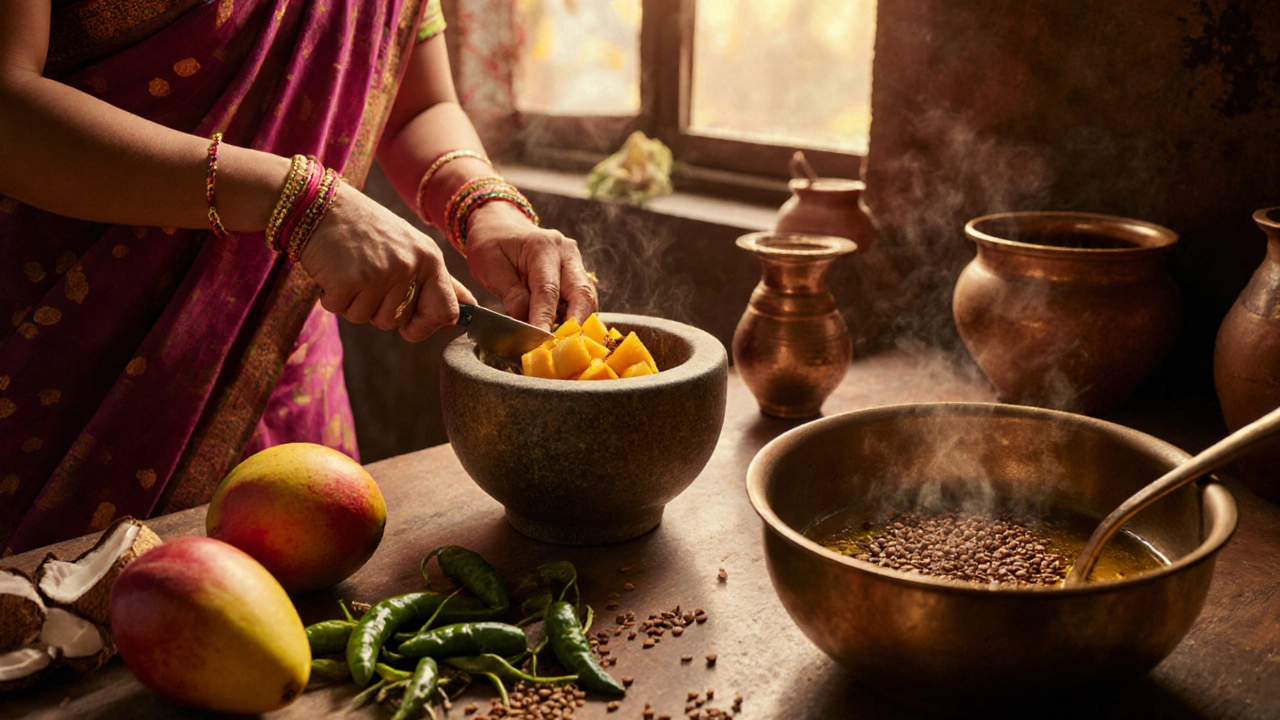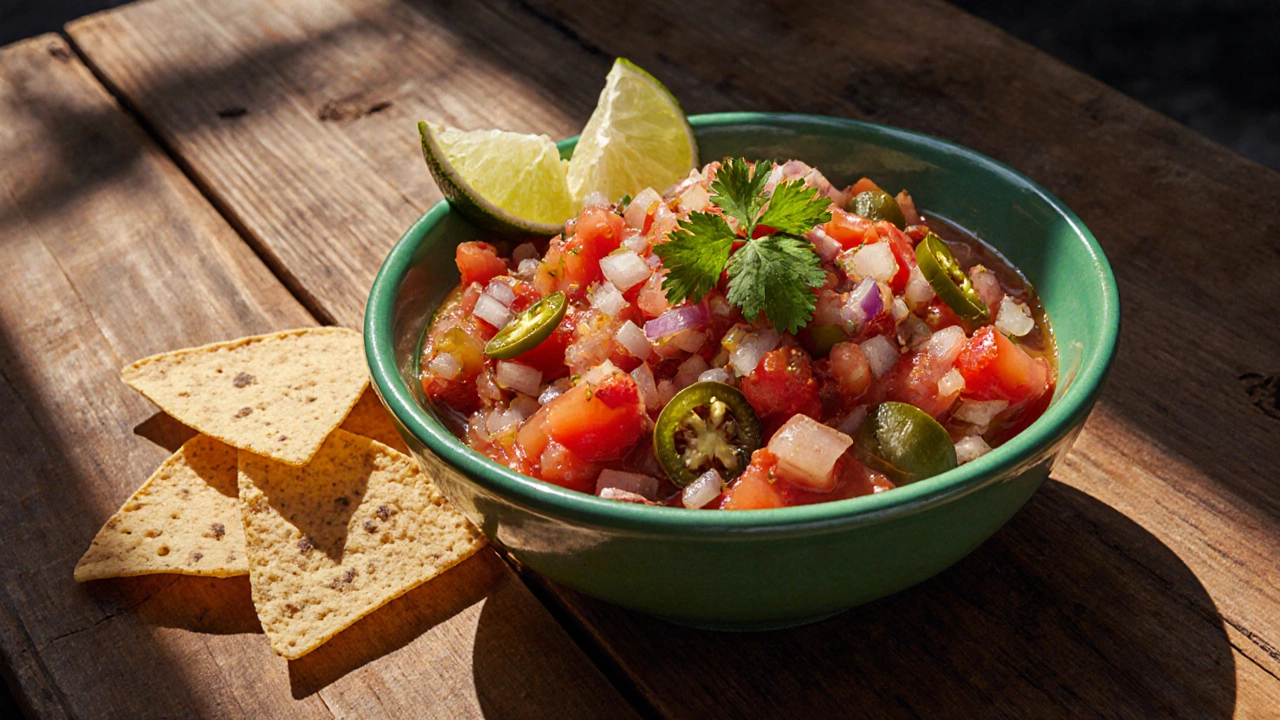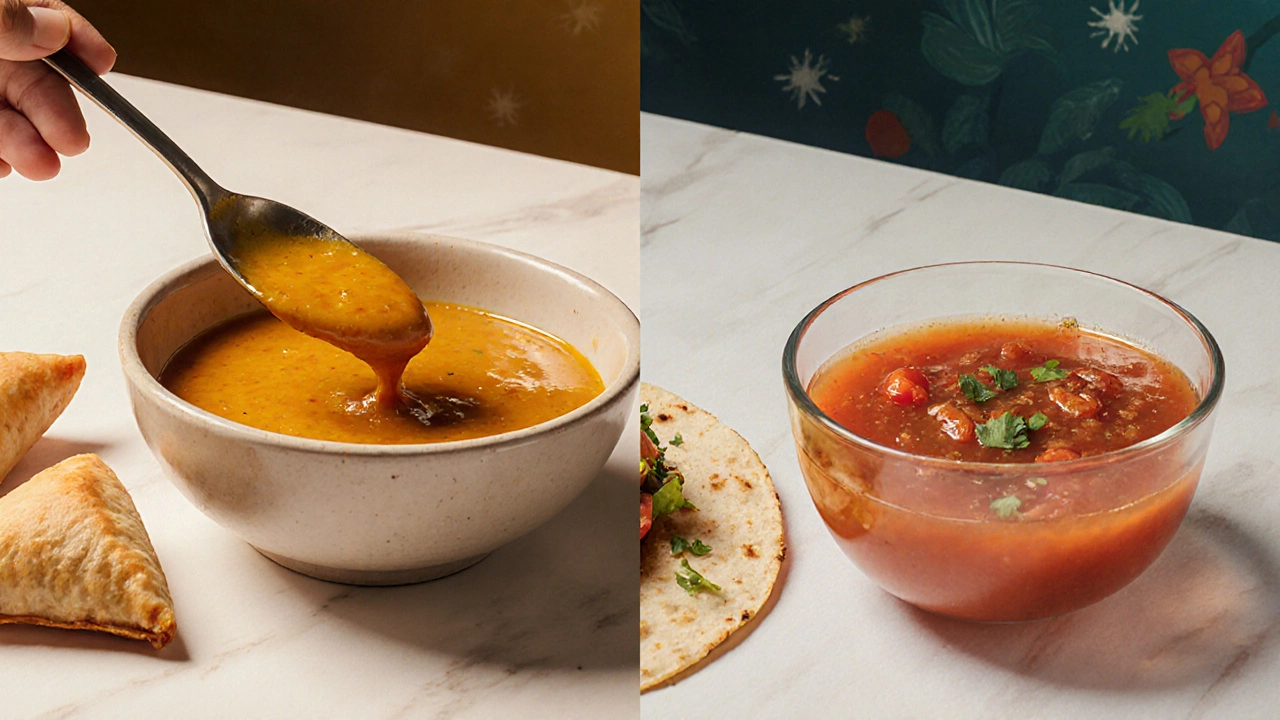Is Salsa a Chutney? The Real Difference Between Two Popular Condiments
20 November 2025

Flavor Balance Calculator
Create Your Condiment
This tool calculates your condiment's flavor profile based on key ingredients from the article.
Ever looked at a bowl of bright red salsa and thought, "This is just like my mom’s mango chutney"? You’re not alone. Many people assume salsa and chutney are the same thing-both are chunky, tangy, and served with food. But they’re not. Not even close. And if you’re trying to nail a chutney recipe, mixing up salsa and chutney will throw off your flavor balance every time.
What exactly is chutney?
Chutney comes from India, where it’s been made for over 2,000 years. The word itself comes from the Hindi word "chatni," meaning "to lick." It’s not just a side-it’s a flavor engine. Traditional chutneys are made by grinding or cooking fresh ingredients like tamarind, coconut, mint, cilantro, green chilies, ginger, or ripe mangoes with spices like cumin, mustard seeds, or asafoetida. They’re often tempered with hot oil to unlock aromas. Some are fresh and raw, like coriander chutney served with samosas. Others are slow-cooked into thick, sweet-sour pastes like mango chutney that lasts for months.
Chutney isn’t just about taste-it’s about balance. A good chutney hits all five flavors: sweet, sour, salty, bitter, and spicy. Think of it as a flavor orchestra, where every ingredient has a role. Even the texture matters. Indian chutneys are often coarse or finely ground, never smooth like store-bought ketchup. They’re meant to cling to food, not drown it.
What is salsa really?
Salsa, from the Spanish word for "sauce," is a staple in Mexican and Central American kitchens. The most common version-pico de gallo-is raw: diced tomatoes, onions, jalapeños, cilantro, lime juice, and salt. It’s not cooked. It’s not spiced with cumin or mustard seeds. It’s bright, acidic, and crunchy. There are cooked salsas too-like salsa roja, simmered with roasted chilies and garlic-but even those don’t use the spices or techniques you’d find in chutney.
Salsa doesn’t aim for complexity. It’s about freshness and punch. It’s meant to be eaten right away. You won’t find sugar in traditional salsa unless it’s a fruit salsa for dessert. No jaggery. No tamarind paste. No toasted spices blooming in oil. Just lime, salt, and whatever’s ripe that day.
Why people confuse them
The confusion happens because both are served with similar foods. Tortilla chips with salsa? Same as papadum with mint chutney. Tacos with salsa? Like dosa with coconut chutney. Visually, they look alike-red, chunky, colorful. But that’s where the similarity ends.
When you taste them side by side, the difference hits hard. Take a spoonful of classic Indian mango chutney: sweet, sticky, with a slow burn from green chilies and a deep tang from tamarind. Now try a fresh tomato salsa: sharp lime, crisp onion, mild heat from jalapeño, watery texture. One is a slow, layered experience. The other is a quick, bright burst.
Even the ingredients don’t overlap much. Chutney uses coconut, roasted cumin, curry leaves, jaggery, dried red chilies, or fenugreek. Salsa uses cilantro, lime, garlic, avocado, or tomatillos. No chutney recipe calls for avocado. No salsa recipe calls for tamarind.

Can you substitute one for the other?
Technically, yes-you can spread salsa on a samosa if you’re desperate. But you’ll miss the soul of the dish. A samosa with salsa tastes like a Mexican snack pretending to be Indian. It’s not wrong, but it’s not right either.
Same goes the other way. Pour mango chutney on tacos? You’ll get a sweet, thick glaze that overpowers the meat and ruins the crunch. It’s like using maple syrup instead of soy sauce on stir-fry. The flavors clash because they’re built for different systems.
If you’re trying to make authentic chutney recipes, don’t reach for salsa. And if you’re making salsa, skip the jaggery and cumin. Stick to what works.
Real examples from the kitchen
Here’s what happens when you mix them up:
- You make coconut chutney for idli, but use tomato and lime instead of coconut and roasted chilies. Result? It tastes like a watery salsa, not the creamy, nutty condiment it should be.
- You try to make a Mexican-style salsa with tamarind and ginger. Result? It’s confusing. The lime and tamarind fight each other. The ginger doesn’t belong. No one knows what they’re eating.
On the flip side, here’s what works:
- Mango chutney with grilled chicken tacos? Surprisingly good. But only because the chicken is rich and the chutney’s sweetness cuts through. It’s an experiment, not a tradition.
- Pico de gallo with Indian chaat? Works if you’re going for fusion. But it’s not authentic. It’s a creative twist.
Authenticity isn’t about rules. It’s about respect for the system. Chutney and salsa are both brilliant. But they’re from different worlds.

What makes chutney unique
Chutney has regional variations across India. In the south, coconut chutney is a daily staple. In the north, tamarind chutney is thick and syrupy. In the east, mustard-based chutneys are spicy and pungent. Each one uses local ingredients and techniques passed down for generations.
Chutney is often made fresh daily. It’s not a shelf-stable product. Even store-bought versions are meant to be eaten within weeks. The spices are toasted, the herbs are hand-chopped, the fruit is ripe, not canned.
Salsa, by contrast, is often made in batches, bottled, and shipped globally. It’s designed for consistency, not nuance. You can buy it in a jar and it’ll taste the same in Tokyo or Toronto.
Final verdict: Is salsa a chutney?
No. Salsa is not a chutney. They’re both delicious. They’re both condiments. But they’re not interchangeable. Trying to call salsa a chutney is like calling a croissant a muffin. They’re both baked, both eaten for breakfast, but that’s it.
If you want to make real chutney, stick to the classics: fresh herbs, toasted spices, tamarind, coconut, or mango. Don’t swap in tomatoes and lime unless you’re going for fusion-and even then, know you’re creating something new, not copying tradition.
Respect the roots. Taste the difference. And next time you reach for a condiment, ask yourself: Am I making chutney? Or am I just making salsa with a different name?
Can I use salsa instead of chutney in Indian recipes?
You can, but it won’t taste right. Indian dishes like samosas, dosas, or chaat rely on chutney’s specific balance of sweet, sour, spicy, and herbal notes. Salsa lacks the depth from toasted spices, tamarind, or coconut. It’ll add acidity and crunch, but miss the soul. Use it only if you’re experimenting with fusion, not if you want authenticity.
Is mango chutney the same as salsa verde?
No. Mango chutney is sweet, sticky, and slow-cooked with sugar, tamarind, and spices. Salsa verde is raw, made from tomatillos, cilantro, jalapeños, and lime. One is a preserve. The other is a fresh sauce. They’re both green, but that’s where the similarity ends.
Why does chutney last longer than salsa?
Many chutneys are cooked with sugar, vinegar, or oil, which act as natural preservatives. Mango chutney, for example, is simmered until thick and then stored in sterilized jars. Salsa is almost always raw and meant to be eaten within days. It has no sugar or thickening agents to slow spoilage.
What’s the closest thing to salsa in Indian cuisine?
The closest is kachumber salad-a raw mix of chopped cucumber, tomato, onion, and lemon juice, sometimes with chili. It’s not a sauce, but it shares salsa’s freshness and crunch. It’s served alongside meals, not spooned over them.
Can I make a hybrid of salsa and chutney?
Of course. Fusion is part of cooking. Try blending roasted red peppers, lime, and a pinch of cumin with chopped cilantro. Add a teaspoon of jaggery for depth. You’ll get something new-call it a "spicy salsa-chutney." Just don’t call it traditional. Own the creativity.